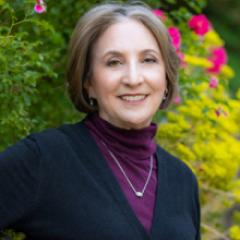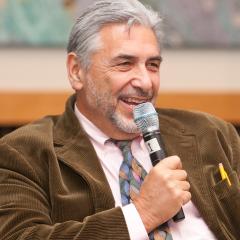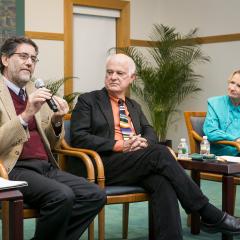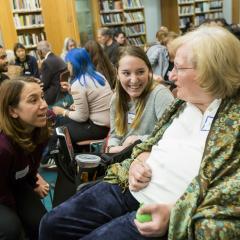Creativity, Peace Building, and Education
On May 14, 2014, we hosted a dialogue session pairing leading scholars with local university students representing a range of disciplines. Featuring education professors Stephen Gould and Bernice Lerner, the topic of discussion was “Creativity, Peace Building, and Education.” This report is by Mitch Bogen.
Report from the Seminar with Gould and Lerner
Creativity and education are unambiguously good, right? Actually, said professors Stephen Gould and Bernice Lerner during their May 2014 dialogue session with local university students, without being careful of how we define these terms and understanding the ways they interact, we run the risk of condoning practices that aren’t necessarily of value for humankind and our world. That said, they argued that creativity and education, informed by wisdom, constitute the foundation for the practices that will lead to peacefully harmonious development in our rapidly globalizing world. Gould and Lerner have significant experience in US K-12 schools, and many of their observations built on those experiences. But the lessons they drew are relevant to us all.
Two Visions
In his opening remarks, Dr. Gould, who is director of the educational leadership program at Lesley University, took care to raise questions about creativity, peace building, and education. “What is the role of schools?” he asked. “Isn’t it to prepare students to be productive, contributing members of a global society? Doesn’t education have the potential to develop in people the capacity to create value that benefits citizens, society, and the future?” He continued by noting that today’s “fixation” with “student achievement” (narrowly defined by the testing movement), has distracted educators from the far more important task of “making our schools places where creativity and peace building play a central role.”
He also offered a framework for understanding the complexity and interconnectivity of creativity, peace building, and education. Assigning three dimensions to each, he stated that creativity can be understood in terms of head, heart, and hand; peace building in terms of dream, design, and deliver; and education in terms of imagination, curiosity, and perspiration. Creativity, peace building, and education, along with all these component parts, Dr. Gould said, are “part of one big web of interconnectedness.”
Dr. Lerner, who is director of adult learning at Hebrew College, as well as a long-time leader in the field of character education, jumped right in with hard questions about the nature of creativity. Is it possible that there are creative evil people? Could it be said that the suspects behind the Boston Marathon bombings, or the men responsible for the carnage of 9/11, actually exhibited forms of creativity, as heinous as their actions were? We are never exempt from the imperative to distinguish good from evil, she said. Without this judgment, the activities of creativity and education are handicapped.
Referencing a compilation of Daisaku Ikeda quotes prepared as background material for the seminar, Professor Lerner emphasized a number of important points, among them these two:
To keep our faith in peace building and global well being, we must always start small, with “a love of neighbor, family, and community—of the immediate.” Otherwise the scale and complexity of global problems may be too “daunting.” This is why the role of the educator, in Daisaku Ikeda’s view, is “to believe in the creativity of each young person with whom they come into contact, cultivate it warmly, and persistently endeavor to enable it to bloom brilliantly.”
Like Daisaku Ikeda, Dr. Lerner appreciates Viktor Frankl’s notion of “attitudinal value,” which manifests most clearly in the context of suffering. These words of Nelson Mandela, shared in one of the Ikeda quotes, spoke powerfully to Dr. Lerner and in her view illustrate attitudinal values perfectly. Writing from prison, Mandela said: “It is only my flesh and blood that are shut up behind these tight walls. Otherwise I remain cosmopolitan in my outlook; in my thoughts I am free as a falcon.”
In conclusion, Professor Lerner quoted Amy Gutmann, current president of the University of Pennsylvania, who wrote that “our primary moral allegiance is to justice,” and not to any particular group identifications. From this “commitment we develop the skills and values of democratic citizenship,” skills and values which embody the vision of education that Dr. Gould identified earlier as increasingly scarce in our schools.
Dialogue on Creativity, Peace Building, and Education
The first student to speak wondered about the “deep disagreement” in the US, including among US educators, over the values young people should learn. Dr. Lerner replied that it is always possible to find values that cut across our religious and cultural identifications, values that “people universally agree to be good, true, and just—for individuals and for the community at large.” Many of the most fundamental universal values, she said, revolve around qualities of caring for the weakest or most vulnerable among us.
Dr. Gould stated that ”it all comes down to education.” Addressing issues of morality must be seen as central to the school’s mission, he said. Schools that fail in this do a disservice to us all. And it’s not just that students can be shown examples of ethical triumphs and failures throughout history, but that schools themselves are “a microcosm of society,” a realm in which concrete matters of morality can be addressed during the everyday life of the school, thus avoiding “the pitfalls of abstraction.” Further, it is a function of creativity for students to learn not to be followers, but “ambassadors” of better modes of being and acting.
The next student speaker followed up on Dr. Lerner’s earlier remarks on the challenge of distinguishing good from evil, observing that it can be a fine line between the two. She said that in her own research she found that as young people Stalin and Hitler sought universal wisdom in ways not dissimilar to the young Martin Luther King, Jr., and Jane Addams. Dr. Lerner reiterated that this need to distinguish good from evil is ongoing, adding that for something to be virtuous it must demonstrate modes of “selflessness, altruism, and goodness.”
At this point, event moderator Kevin Maher contextualized the discussion by sharing a quote from Daisaku Ikeda on how the concept of “value creation” can guide our actions and clarify what is truly good. “Value creation,” said Mr. Ikeda in his 1996 lecture at Teachers College, “is the capacity to find meaning, to enhance one’s own existence and contribute to the well being of others under any circumstance.”
The dialogue then moved on to another topic introduced by a student, namely how specialization in academics and the orientation toward information accumulation relate to questions of creativity, peace building, and education. Professor Lerner said that she encourages educators to use stories to illustrate what peace building and related virtues actually look like in practice. Stories, she said, help us “to think beyond disciplines.” Gould said that creative teaching and learning always includes an effort to see things differently, to identify patterns, and to make meaning out of information. These skills, he said, “don’t belong to any one discipline and are important to all.”
Creating Value, No Matter What
As the dialogue moved toward its conclusion, Gould and Lerner emphasized that it is a teacher’s responsibility to create value in our schools, regardless of circumstances, especially those related to the “top-down” pressures of the standardized testing movement, with its harsh consequences for schools not meeting state and national benchmarks.
Teachers can create value in a number of ways, they said. One student suggested, and Gould and Lerner agreed, that modeling creative problem-solving behavior is an excellent way to help students learn critical lessons not included on the tests. No matter the lesson plan, teachers can demonstrate in and out of the classroom the creative behaviors that will contribute both to individual success and social well being. Another strategy, said Lerner, is to treat the testing regime as an opportunity for character education, as the discipline and focus needed to do well on the tests are traits that will carry students far in life. All the teacher needs to do is “shift the lens a bit,” she said.
Gould concurred, saying that teachers’ “hands are not fully tied,” and that testing “mandates” can become a convenient excuse for teachers not to become the leaders needed to revive education as not simply a mode of competition but as the most important mode of creating a citizenry capable of advancing democracy and the values needed in our globalizing world.
So how do creativity, peace building, and education merge and interact for the good of humanity? Echoing Dr. Gould’s earlier observation, Lerner suggested it happens when a teacher, or any of us, models “another way of being in the world,” a way not constrained or defined by the outside or oppressive forces we might encounter. In so doing we manifest Frankl’s “attitudinal value.” Gould suggested they merge when we have the integrity to “stand up to right a wrong.” And most of all they interconnect when we find ways “to solve problems together.” This, he said, is the key to creating “a world that functions in harmony.”




